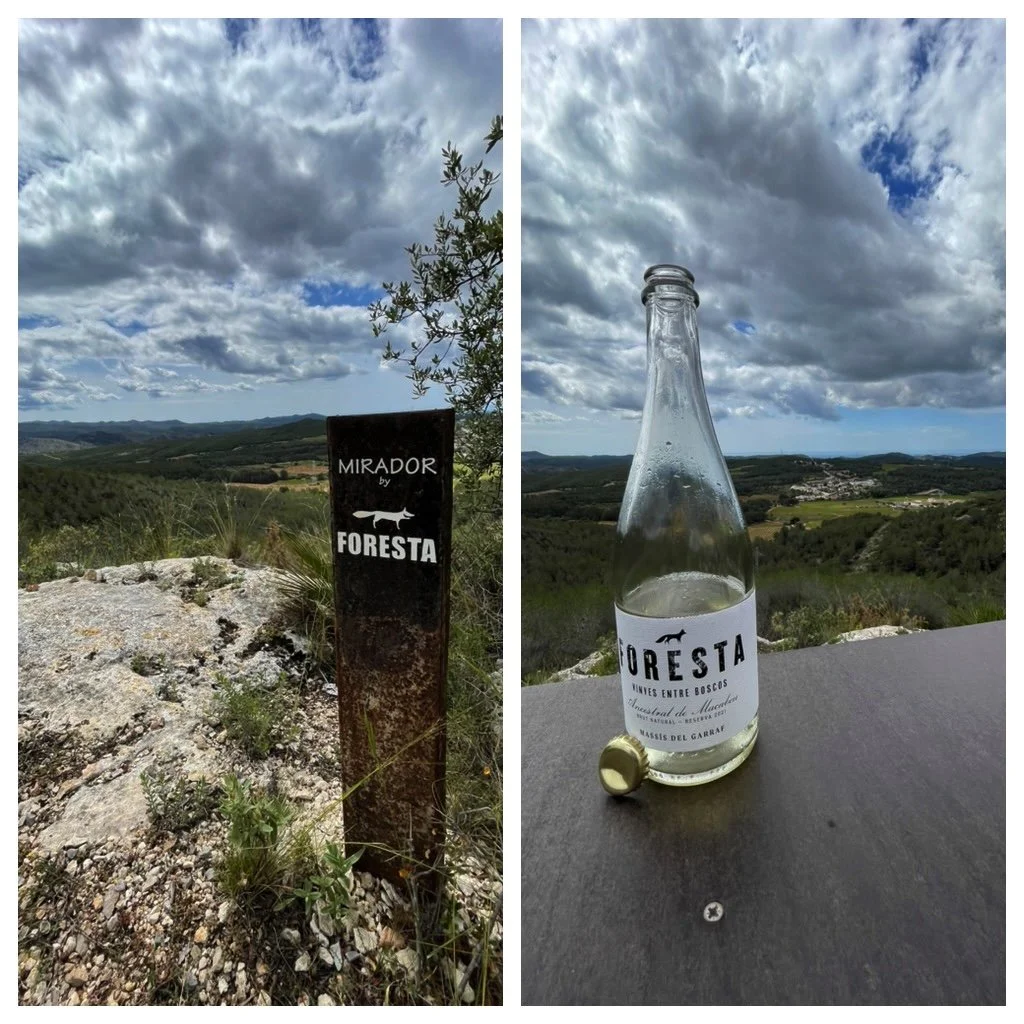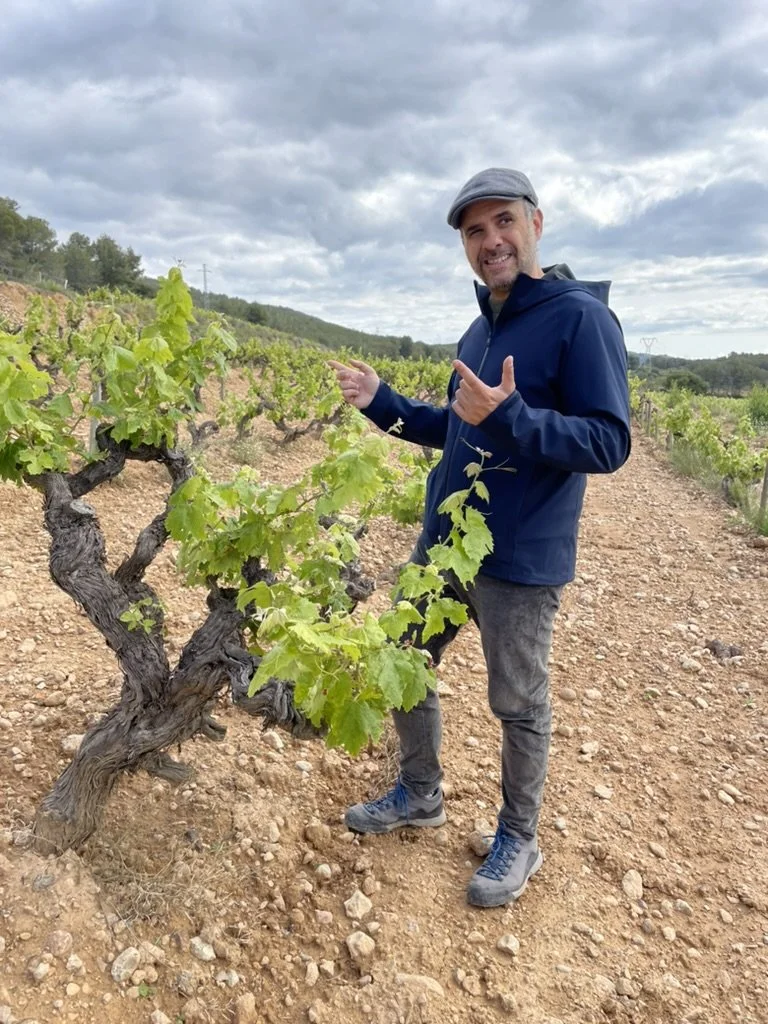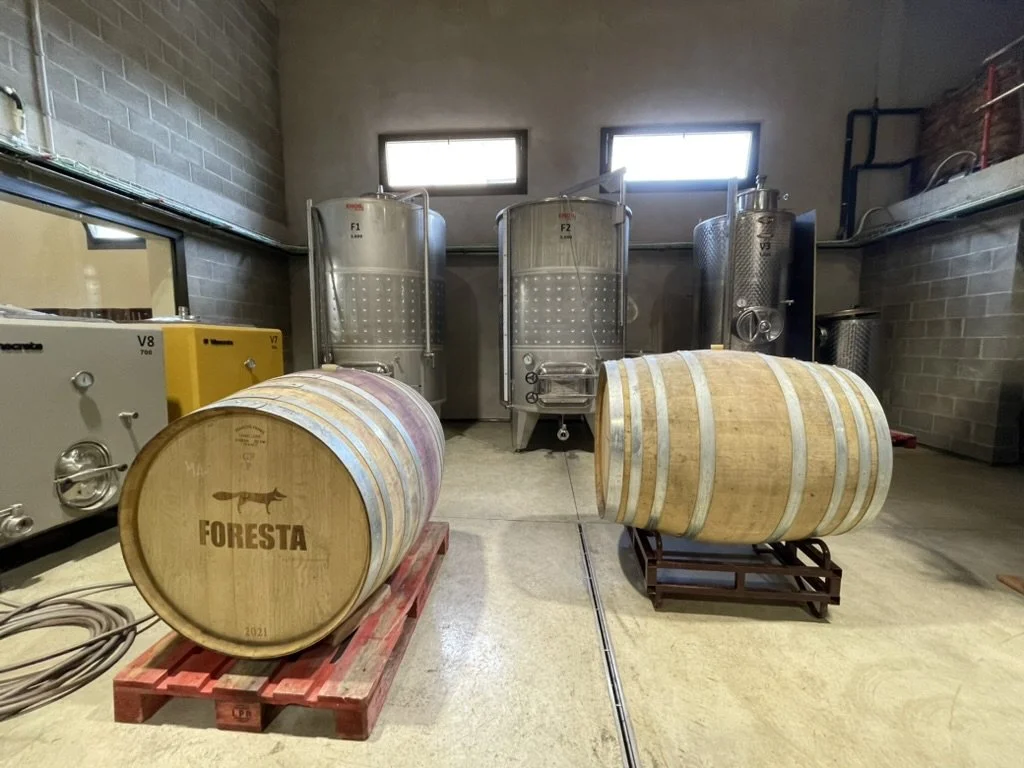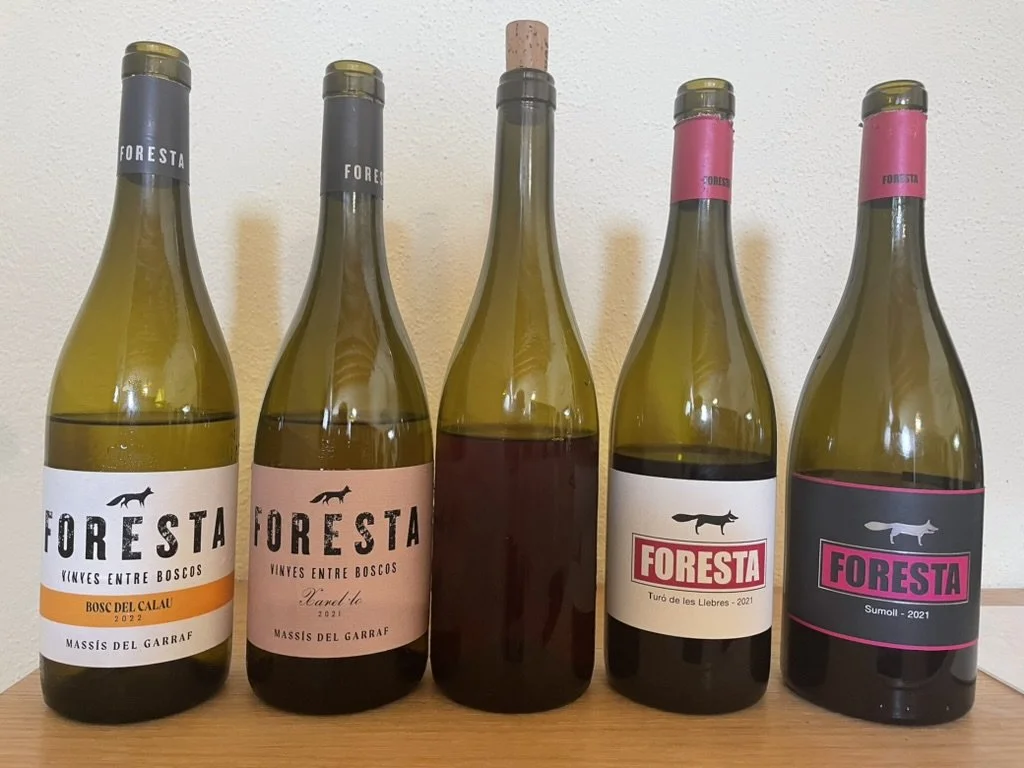The wines of Foresta
Alan Nance visits grower–producer Gerard Maristany in the Massís del Garraf.
As I step down from the Land Rover, the wry smile on Gerard's face makes it clear that he never doubted the battered old vehicle would make it up the track to the top of the Serra de les Gunyoles. The ridge peaks a little short of 400 m above sea level, and it is the perfect place to appreciate the lay of the Penedès land. To the east lies the Mediterranean Sea, and before it the limestone hills and gullies of the Massís del Garraf. To the west, the central valley of the Penedès spreads itself before me, the mosaic of vineyards sliced through the middle by the AP-7, the motorway that runs the length of the eastern seaboard of the Iberian Peninsula.
Looking over the central valley of the Penedès from the Serra de les Gunyoles
(map © Institut Cartogràfic i Geològic de Catalunya)
"You see that building with the red-brick roof, just the other side of the motorway?" "Well," says Gerard, "that's more or less where my family's vineyards are." The smallholding, he tells me, has belonged to his family since the 1870s, and his great-grandfather is alleged to have been one of the first in the region to plant Pinot Noir. Nowadays, however, the vineyards are planted with Xarel·lo and Macabeu, which Gerard uses to make a series of wines under his own Viladomat-Aragó label. He is also, however, a partner in Foresta, a project rooted within the bounds of the Garraf Natural Park, and that is the winery I have come to visit today.
To kick things off, Gerard has brought me up onto the ridge that divides the two terrains, the flat and fertile central plain from the scrubland and forests of the arid Massís. The presence of these forests, he explains, is one of the factors that help to maintain a certain humidity and relatively low temperatures during the ripening season. The other is the marinada, the sea breeze that bathes the Garraf and which is prevented from dissipating into the central valley by the chain of coastal ridges such as the one on which I'm standing. Gerard beckons me to follow him as he picks his way along a narrow path that seemingly leads nowhere, before suddenly emerging onto a flat outcrop crowned with a rectangular stone table that has clearly been fashioned from the very rock on which it sits.
"We like to think of it as our outdoor tasting room", he says, as he pulls from his backpack a couple of glasses and a bottle of sparkling Ancestral (aka pét-nat) made from Macabeu. The wine is crisp and fresh, green apple laced with a hint of grapefruit, yet with a bit of depth too. I see from the bottle that it is the 2021 vintage, which Gerard tells me spent 30 months on lees before disgorging.
The outdoor tasting room on the Garraf side of the Serra de les Gunyoles
Ancestral de Macabeu Reserva 2021 (11% ABV)
The Massís del Garraf is a challenging place to grow grapes, and that was the case even before the drought that has affected this part of Catalonia for the past three years. The calcareous soils are poor in nutrients and often shallow, in some places barely a hand's depth atop the limestone bedrock, and this is another factor that shapes their character.
After driving back down from the ridge, Gerard shows me one of their parcels of Xarel·lo. The bush vines were planted around 55 years ago and are part of the 60 hectares of land that belong to Lluís Carsí, the other half of Foresta. Aside from Xarel·lo, there are also parcels of Macabeu and Sumoll, as well as some Garnacha Tinta, Cabernet Franc and Marselan (a cross between Cabernet Sauvignon and Garnacha that was first planted in the region during the 1990s by Carlos Esteva of Can Ràfols dels Caus).
All the Foresta vineyards have been farmed organically since 2012, which brought particular challenges in 2020 when the whole region was blighted by mildew. It's not got any easier. The weather during the 2023 growing season saw production reduced by 50%, and this year, just a month before my visit, the Xarel·lo vineyard had been hit by hail. Gerard estimates that half of the potential harvest was lost. But they carry on, and the quality of the wines they produce augurs a bright future, climatic and other challenges notwithstanding.
Gerard in one of the Xarel·lo vineyards of Foresta
Minimal intervention is very much the order of the day at Foresta, with only small amounts of SO2 being used at bottling. All fermentations are with native yeasts and take place in either stainless steel tanks, barrels (French oak or chestnut) or concrete vats, depending on the wine and the profile being sought.
Inside the winery
For riddling the Ancestrals, they use a manual device that is a predecessor of the modern, mechanized gyropalette, referred to colloquially in Catalan as a baldufa, or spinning top.
The manual riddling device can hold up to 250 bottles
So, what about the wines? Aside from the Ancestral Macabeu that I had tasted up on the ridge, Gerard uncorked a further five for me to taste. First up was the Bosc de Calau 2022 (12.5% ABV), their entry-level varietal Xarel·lo that is bottled after spending 5-6 months on lees in stainless steel tanks. This is a lovely unadorned expression of the variety, in which notes of white fruit, lemon and thyme are offset by a saline and mineral core.
The profile is a little different in the next wine, also a varietal Xarel·lo (13.5% ABV) but this time fermented and aged in 500 L French oak barrels, followed by at least a year in bottle prior to release. While there is still a stony saline edge here, this is a more structured and complex wine, with bolder fruit, hints of sweet spice and intense notes of those scrubland herbs that pepper the surrounding landscape. One to enjoy and drink now, without a doubt, but also a wine that would surely show the aging potential of Xarel·lo if stashed in a suitable place for a few more years.
The next wine that Gerard uncorked, a clarete made from a blend of Cabernet Franc (75%) and Sumoll (25%), is an experimental product that is yet to be released, although it should be available by the end of June. Both varieties underwent a short maceration of just a few hours and were fermented separately in stainless steel before being blended. Their decision to call it a clarete, rather than a rosado, makes sense once the wine is poured, for it's the colour of a pale pomegranate seed. I found this unassuming wine to be fresh and full of life, a delicious glou-glou that could see me through the summer, and beyond.
The Turó de les Llebres 2021 (12.5% ABV) is another blend, in this case of Garnacha Tinta, Sumoll and, in this particular vintage, a little Petit Verdot. The varieties are fermented separately, part in concrete vats, part in open barrels, and are then brought together for around six months in stainless steel tanks before bottling. Immediately approachable, yet with a lingering finish, the wine manages to combine a certain rusticity with a smoother more elegant side, making it all rather moreish. If you take another look at the map in the first photo, you'll see, close to the Serra de les Gunyoles, the peak that lends its name to this wine.
Finally, I got to taste the varietal Sumoll 2021 (11.5% ABV). For many years sidelined as a tricky-to-grow grape, the potential of this old Catalan variety is now being revealed through wines such as this. Fermented and aged for eight months in used French oak barrels, followed by a year in bottle, this offers juicy red fruit acidity backed by fine tannins and echoes of scrubland herbs and purple flowers. Garraf in a glass.
The five wines tasted (the clarete is unlabelled as yet to be released)
Attentive readers may already have noticed from the above photo that there are two different label designs. The two on the right show the original Foresta label, the two on the left the new design that is now being used for all bottling. Importantly, now that the Massís del Garraf has achieved official recognition as a unique sub-region within the DO Penedès, wineries such as Foresta can display this indicator of origin on their front labels, with the Penedès designation being relegated to the back or side.
Aside from this administrative detail, it strikes me that the new labels also evoke a growing sense of self-assurance in what is still a relatively young winemaking project, one that like a fine Xarel·lo looks set to gain in character as it evolves. I for one will be following the Foresta trail in years to come.
[All the Foresta wines are available through their web shop]






